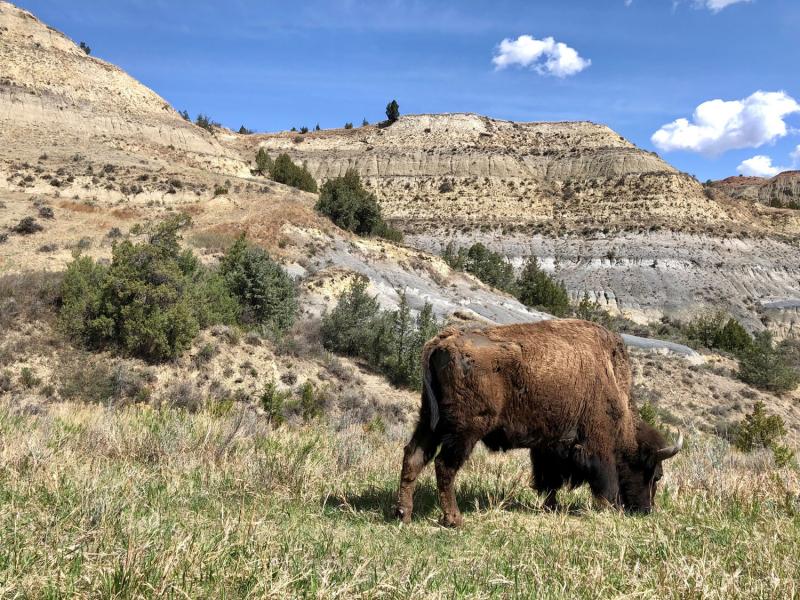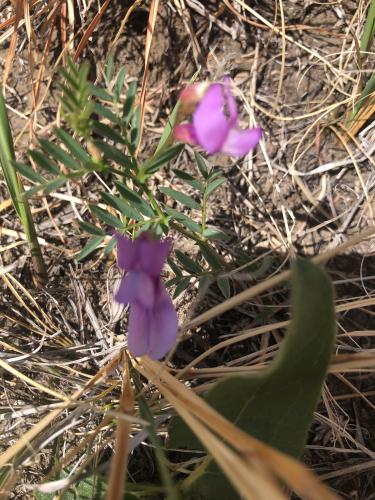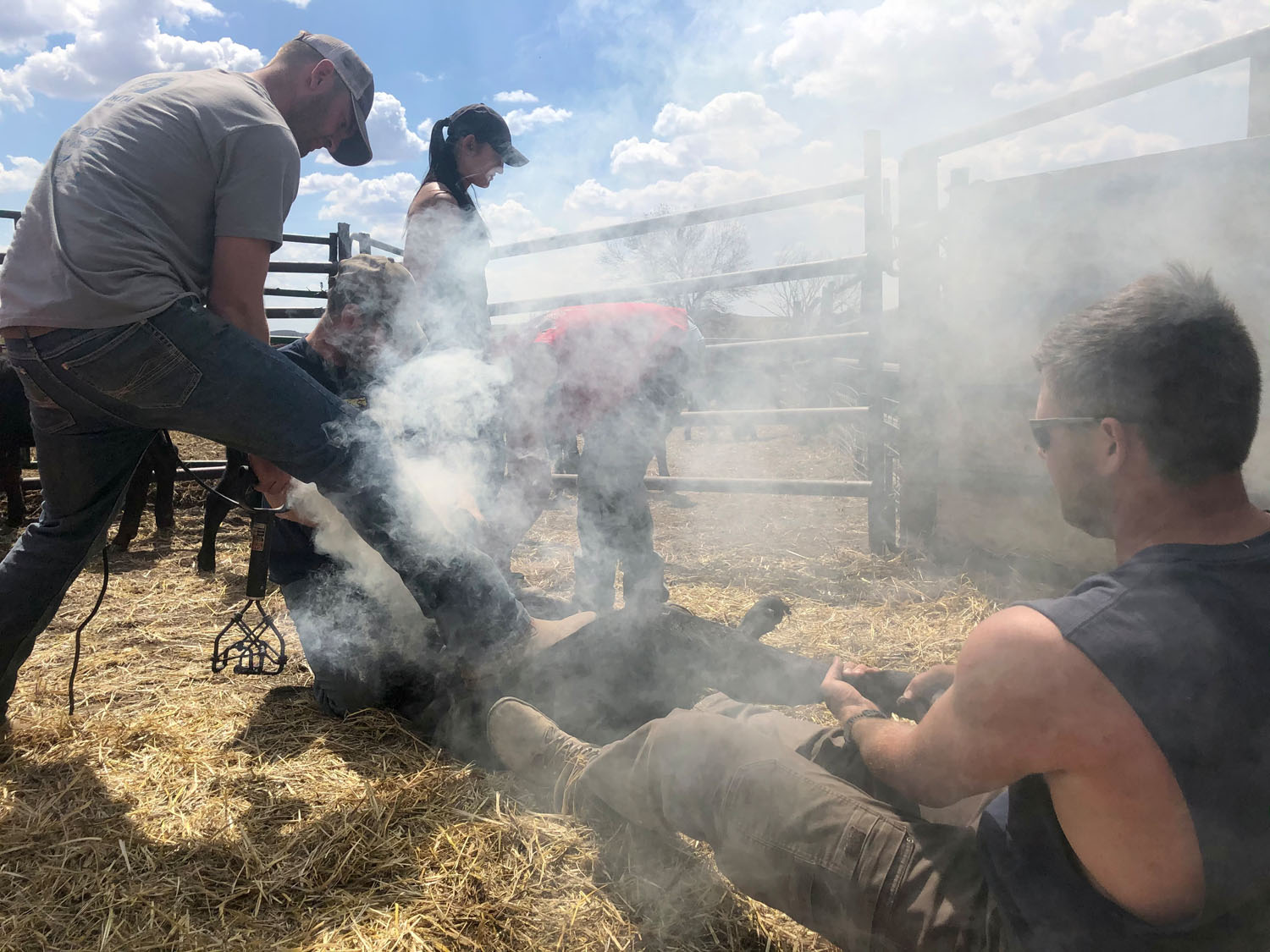1.
One man grabs a calf’s hind leg and lifts. Another seizes a front leg and heaves, flipping as easily as possible the two-hundred-pound animal. Then each man pulls hard to keep it still. Even a calf two months old can pitch a person pretty far. “They will roll you,” the ranch matriarch warns.
Next comes a swift procession of people. One leans in to give a shot, vaccinating against sickness. Another tags the ear. Another castrates. Finally, the guy with the red-hot brand pushes it into hair and skin to sizzle and smoke, marking the calf in its first-ever May for the rest of life.
Calves will typically spend summer and fall fattening on open pasture, a seasonal grazing here in the rolling plains of western North Dakota that feeds fast food restaurants and stocks supermarket shelves many months later. This afternoon, though, there’s uncertainty about the system.
Over the corral fence, a man who has spent more than fifty years in and around the place loads another syringe with vaccine and ponders the prairie. “We need rain,” he says. Then, again: “We need rain.”
A rancher from up the road puts more than a year of little precipitation into context. “I’m sixty-five years old,” he says, “and I’ve never seen it this dry.”
Needlegrass, wheatgrass, wildrye, and other early-season forage didn’t grow well. Cordgrass, grama, and other summer stems may not either if rain doesn’t come.
The branding done, calves are reunited with frantic mothers. Back at the ranch house, nearly a dozen people rest on a long porch over plates of a potluck feast. One man talks about how he still has to feed expensive hay to his herd. “If I can make it till fall, I think I’ll sell half my cows and all my calves,” he says.
Another man mentions moving cows sooner, as Chinese bidders are buying more meat from the US. “If you don’t lock in your prices,” he says, “you’ll go broke.”
Exhausted eyes shift in the shade. Silence between swigs of cold beer and bites of beef.
2.

John Heiser was born and raised on a ranch near the north unit of Theodore Roosevelt National Park. During decades of his adult life, he has been drawn into the badlands as a backcountry ranger. “I can’t stand straight lines. I can’t stand concrete. All of these artificial things,” Heiser says. “My spirit is like, Let me out, let me out, let me out.”
He feels at home among wild bison, understanding when and how to approach a grazing herd. He knows where to be with bighorn sheep. He sits on a ridge and eyes a distant cliff, where eight lambs idle alongside ewes. “See these moms with their babies,” Heiser says. “One’s right at her feet, and the other one’s nursing. Just like calves at the ranch: Moms rule.”
A Rocky Mountain juniper, late to leaf, offers scant shade. Field sparrows and western meadowlarks shift above brittle grass. A golden eagle and a turkey vulture search high currents.
Heiser holds an index-card inventory of poetry that resonates in the wildness.
Navarre Scott Momaday:
…For we are held by more than the force of gravity to the earth.
It is the entity from which we are sprung, and that into which we are dissolved in time.
The blood of the whole human race is invested in it.…
Heiser catalogs data too. This, from a weather station at his home, in a dispatch sent to friends: “…Precipitation was 34% of normal, the year-to-date precipitation total of .86 inches far below the average of 2.70 inches & 32% of normal…bringing the seasonal total to 18.1 inches, 48% of the annual total of 37.8 inches.”
Days, months, years. Tracking details and trends that scientists confirm. The Great Plains adapts to the Anthropocene with extremes. 2017 dry. 2019 torrential. 2021 again a season of thirst.
Shuffle the stack of indexed verse. Caroline Fraser:
…The inmates running the asylum. See them in their little cars, whizzing?
Stop and go!…
What can be done to restore order?
Give the government over to the insects, for the tidy digestion of all that dung, give the infants to the higher mammals with the softest fur.…
3.
 Purple petals struggle for survival in the grassland of Theodore Roosevelt National Park, as wild a place as remains in the prairie. Beneath the flower’s slender stalk, the ground is brown and barren. This spring saw the most intense drought so far this century in North Dakota.
Purple petals struggle for survival in the grassland of Theodore Roosevelt National Park, as wild a place as remains in the prairie. Beneath the flower’s slender stalk, the ground is brown and barren. This spring saw the most intense drought so far this century in North Dakota.
Mule deer, flourishing after a mild winter, wander on thin earth. Ducks, which turn to pothole ponds each spring, choose not to mate. Not a single seasonal hole holds water. Mallards, the most populous breed on the plains, give birth at less than half the rate of the year before.
Cyanobacteria, blue-green algae, lurks at the edge of dried basins. The algae’s toxic blooms threaten wildlife and livestock. In farmers’ fields, seeds don’t sprout. Durum wheat, soybeans, flaxseed, canola, and peas die in dirt.
“It ain’t gonna grow in the bins,” one farmer says. “We’ve got to put it in the ground and hope the good Lord will turn the spigot on.”
Through May, almost no rain. Hard to fathom in a landscape carved by the Missouri and Yellowstone rivers, and buoyed by underground aquifers, that water could get this scarce this fast. The last time the place dried severely, fifteen years ago, the Army Corps of Engineers lowered artificial lakes to reinforce hydroelectric power for the region. When the natural cycle breaks, so too does so much built upon it. Wildfire sparks and spreads: 156 square miles burned in more than 1,400 blazes.
On some June afternoons, rain sifts down in fits, but not enough to nourish roots. When it does eventually arrive in force, water will likely fall too heavy, too fast, flooding. Meanwhile, in the dry air, the flies bite.
So, not far from the staggering flower petals in the preserved pasture, bison wallow. It is a natural habit of the species; the big beasts stomp and roll, trying to soothe bitten skin. This summer, though, there is too much dust. The bison, thirsty too, turn toward blue sky.
These dispatches are from #VQRTrueStory, our social-media experiment in nonfiction, which you can follow by visiting us on Instagram: @vqreview.








